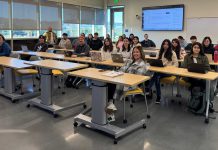
From missives penned during the American Revolution to emails from Afghanistan, an exhibit of soldiers’ letters opening at Gavilan College Monday offers glimpses into the horror and humanity war.
Called War Comes Home, The Legacy, the exhibition comes with an open invitation to veterans and families to donate wartime correspondence to a collection of more than of 100,000 letters and that continues to expand.
Ever since his at-first small collection of letters was mentioned by Dear Abby in 1998, “It has grown by leaps and bounds,” said Andrew Carroll, director of the Center for American War Letters at Chapman University and co-curator with associate professor John Benitz of Chapman.
“The flood gates opened,” he said. Letters poured in from veterans of every military branch and every U.S. conflict, including both world wars, the Korean and Vietnam wars, Afghanistan and Iraq—the latter two including emailed letters.
Overwhelmingly from the rank and file, the collection also some big names, too, such as Roosevelts and novelist Kurt Vonnegut—the Slaughterhouse Five author fought in the Battle of the Bulge in World War II and as a prisoner of war survived the American firebombing of Dresden, Germany.
Carroll’s mission is to save voices such as Vonnegut’s and all the unknown warriors and to “make sure they are heard…we want to preserve a million letters, the biggest collection in the world,” said Carroll, of Washington, D.C.
He will be on hand during the exhibit’s official grand opening and reception Thurs., March 19 at the Gavilan College Library in Gilroy.
He described the letters as unparalleled, eyewitness accounts of history.
“In this day an age, when the younger generation feels letters are quaint, trivial artifacts, the opposite is true,” Carroll said. “Letters in times of war contain some of the most riveting, compelling first-hand accounts of history ever written.”
Judy Bozzo of Gilroy knows first hand.
While going through personal belonging of her deceased grandmother, born in 1892, Bozzo found folded, faded letters penned during the Civil War by relatives–three Union soldiers and family members writing to them.
One that Bozzo calls “the dearest” is a love letter, a poem really, signed with the initial M. She believes it was written by Matthew McCreight who, along with John and William McCreight of Tranquility, Ohio, went to war with the 129th Regiment of the Ohio Volunteers in 1861.
“The fact that we can even read any (of the writing) is amazing,” after more than 150 years, Bozzo said.
After hearing about Carroll’s work, she said she might donate her letters to his collection.
That collection-turned-archive began when Carroll’s home burned down when he was in college and he became keenly aware of the family history lost.
And when soon after the fire a cousin sent him a letter the cousin had written as an American GI walking through the Nazi concentration camp at Buchenwald, Carroll saw its value as history worth preserving for future generations.
Since then, Carroll’s work has been the subject of PBS documentaries, New York Times best-selling books and a play, with all proceeds going to veterans groups, a promise he made to himself when he started his collection nearly 25 years ago.
War Comes Home: The Legacy runs March 16 to April 24 in the Gavilan College Library, 5055 Santa Teresa Blvd., Gilroy. Admission is free. The grand opening reception featuring Andrew Carroll is March 19, 6–7:30 p.m. in the Social Sciences bldg., room 210. For more information, go to gavilan.edu/library or call (408) 848-4810.
The exhibit is a partnership between Cal Humanities, California State Library and Exhibit Envoy and is funded in part by the National Endowment for the Humanities. For more information, go to www.warletters.us.









